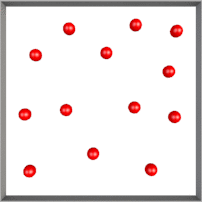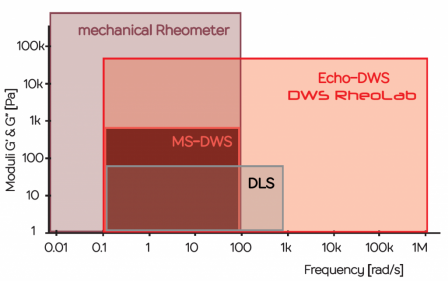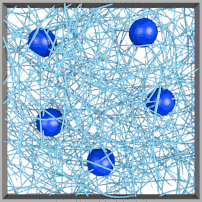Microrheology
Microrheology is a rheological method that uses colloidal tracer particles, dispersed within a sample, as probes. Tracer particles (with diameters ranging from 0.3 to 2.0 μm) may be naturally present in the system, as in suspensions and emulsions, or added to the medium under interest. The motion of the tracer particles reflects the rheological properties of their local environment. In purely viscous samples, tracer particles freely diffuse through the whole sample (Fig. 1a), which results in a particle mean square displacement that is linear with time (red line in Fig. 2a).
where D is the particle diffusion coefficient as expressed by the (Standard) Stokes-Einstein equation:
Fitting the measured with these equations yields the viscosity η of a Newtonian solvent containing tracer particles with known radius R. However, in materials that also contain elastic components, the
shows a more complex time-dependency, which makes the above equations not generally applicable.

Fig 1: a) Particles freely diffuse in purely |
Fig 1: b) Particles trapped in a |
This can be illustrated with the example of a gelatin solution containing polystyrene tracer particles. At elevated temperatures (e.g. 50°C), the gelatin solution behaves purely liquid and the tracer can diffuse freely (Fig. 1a). However, at low temperature (15°C), the gelatin forms a gel and the tracer particles are trapped within the network (Fig. 1b). The thermal energy (Brownian motion) only allows local deformation with amplitudes that depend on the stiffness of the local environment. The restricted motion of the tracer particles is reflected in a mean square displacement that shows a plateau (blue line in Fig. 2a) with amplitude corresponding for the maximal displacement. This is characteristic of the strength of the gelatin network. Many materials are complex fluids that exhibit both viscous and elastic behaviors. For this reason, they are called viscoelastic materials. Their response typically depends on the length and time scale probed in the measurements. A natural way to incorporate viscoelastic behavior is to generalize the Stokes-Einstein relation [1]
This equation allows calculation of the frequency-dependent storage G′(ω) and loss G″(ω) moduli from the measured . In our example of the gelatin solution, the values obtained for G′(ω)and G″(ω)from microrheology are shown in Fig. 2b. At high temperatures (red line) G″(ω) is proportional to the frequency ω, indicating a pure liquid, whereas G′(ω) is very small and out of plotting range. However, at low temperatures (blue lines), G′(ω) dominates G″(ω) over an extended frequency range; only at very high frequency, a cross-over to a domain where G″(ω) is larger than G′(ω) is observed. Such a behavior may be approximately described by the Kelvin-Voigt model (Fig. 2c), which consists of a spring and dashpot connected in parallel. The spring stands for elasticity of the gelatin network, whereas the dashpot represents a viscous damper that describes the dissipative effect of water around the gelatin network.

Fig. 2: a) Mean square displacement from freely diffusing (red) and trapped (blue) particles. b) Storage G′(ω) and loss G″(ω) moduli from freely diffusing (red) and trapped particles (blue). c) Kelvin-Voigt model consists of a spring and a dashpot connected in parallel.
Most microrheology methods are said to be "passive", i.e., they exclusively rely on thermal energy (i.e. Brownian motion) to displace the tracer particles within the sample. Some specialized methods (e.g. optical tweezers, magnetic microrheology) are "active". In the case of active microrheology, an external force (optical, electric, or magnetic) moves the tracer particles with energies that are stronger than the thermal energy . The advantage of active methods is that the amplitude of the particle displacements can be controlled, which allows performance of both linear or non-linear rheology. On the other hand, passive microrheology is ideal for measurements in the linear viscoelastic region (LVR) because the weak thermal energy,
, ensures small amplitudes in the displacement of the tracer particles.
Microrheology can be further differentiated by the method used to measure the of the tracer particles. The most common techniques are particle tracking, DLS microrheology, and DWS microrheology [2].
Here, we present a comparison of the available techniques used to characterized rheological properties of materials.
As Fig. 3 shows, the DWS RhoLab, thanks to its patented Echo technique, is able to cover an extremely huge frequency range and measure large moduli in samples such as firm gels and concentrated polymer solutions.

Fig. 3: linear viscoelasticity range accessible through mechanical rheometer, MS-DWS, DLS and Echo-DWS RheoLab.
[1] T.G. Mason and D. A. Weitz: Optical Measurements of Frequency-Dependent Linear Viscoelastic Moduli of Complex Fluids, Physical Review Letters 74, 1250-1253 (1995).
[2] B.W. Mansel, S. Keen, P.J. Patty, Y. Hemar and M.A.K. Williams: A Practical Review of Microrheological Techniques, Rheology - New Concepts, Applications and Methods, Associate Prof. Rajkumar Durairaj (Ed.), ISBN: 978-953-51-0953-2, InTech, DOI: 10.5772/53639 (2013)

